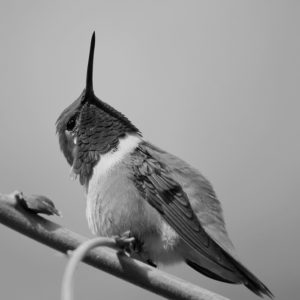There’s such a push for housing on the south island that developers are buying up and tearing down any unprotected piece of forest they can find. It’s a great boon for local economies, of course; people in construction jobs keep on working and the influx of new residents helps to increase our tax base. But one of the losers in this scenario are the ones who depend on the forest for their very lives.
“It’s one of those difficult things, because the human population grows, and everybody wants to make money, it seems,” says North Saanich-based bird photographer Terry Venables. “It’s a tough situation when you love nature, to see the habitat destroyed; it’s really tough.”
Some see economic growth while others feel the loss of our green space and the resulting threat to biodiversity very keenly.
“People are very divided on a lot of different subjects; you almost have to be guarded on your viewpoint because people will jump on you and say you are wrong, or you don’t have a right to think that way or something,” says Venables. “But we do have people out there that are thinking about the environment and our natural beauty that we have here.”
Plumage: The Majestic Art of Birds, on now at The Robert Bateman Centre, is a celebration of natural beauty in the form of birds, created by artists JJ Audubon, Fenwick Lansdowne, Allan Brooks, and Robert Bateman. Also on show is a collection of carvings, prints, and dioramas, as well as Venables’ highly detailed photographs of hummingbirds, ducks, and herons.
“We had bird feeders from the time I was little, and had bird books. It’s one of those neat things that kids can do—you look out the window at the bird feeder and then you get the book and you go, ‘Oh, that’s a junco,’ or, ‘Oh, hey, look—there’s a woodpecker,” says Venables. “It’s quite incredible because there it is, it’s right outside your window. It’s kind of mysterious, but it’s right there in your yard and all around and people don’t even notice.”
Canadian painter Robert Bateman has spent his life carefully watching and meticulously painting birds. Like Venables, Bateman started his career in the arts and as a naturalist while still just a child.
“All little kids love doing art—and nature, for that matter—but most of them grow up around the age of 12 and go on to more grown-up things, and I just never grew up,” says Bateman. “That’s when I got serious—when I was 12 and I painted every hawk and owl in North America. By the time I was 16, they were just little paintings and I did them in a series.”
Coming of age in the 1950s, when contemporary art was ruled by the expressionists—painters like Jackson Pollock and Robert Motherwell—Bateman was convinced that bird art was finished, until one afternoon at the Royal Ontario Museum when he experienced an epiphany.
“The third floor was the natural history floor and they had a rotunda at the middle of it, and then a kind of a very large alcove where they had rotating exhibits,” says Bateman. “We were all just hanging out, and here was this exhibit and this young pipsqueak Fenwick Lansdowne, who was better at painting feathers—by far—than I was. [Lansdowne] did these wonderful bird paintings; I thought, the last five or 10 years, there’s nothing more to be said, and he came along and he had a new approach, so he influenced me to eventually going back into bird art.”
Bateman, who is now 88, has travelled the world in search of bird sightings, but it’s an early memory from his teen years in Toronto that comes to mind when he thinks about spectacular sightings.
“It was in the wintertime, and I was sort of crunching through this frozen cattail marsh and I scared a pheasant up,” says Bateman. “It burst into the air like an explosion, and then out of nowhere came a peregrine falcon. The peregrine falcons attack by striking with their feet and stunning their prey, and it hit the pheasant with its feet, so the pheasant squawked even louder. But it didn’t fall or anything—it changed direction and went off squawking. The peregrine was startled by seeing me there. That moment with the peregrine and the pheasant, it was quite an encounter.”
Bateman is a positive person who, when asked about the threat to biodiversity on this planet, refers to the Serenity Prayer, which calls for serenity to accept what can’t be changed, courage to change what can, and wisdom to know the difference between the two.
“Birds are like the canary in the coal mine,” says Bateman. “They used to, before they had instruments, bring a canary in a cage into a coal mine and the canary would collapse or maybe die before the people did because they’re more delicate—if the canary is in trouble you better get out of the mine. Birds are an indicator, because if the birds are dying, we’re next.”
Plumage: The Majestic Art of Birds
Until Wednesday, June 5
Robert Bateman Centre
470 Belleville Street
batemancentre.org

